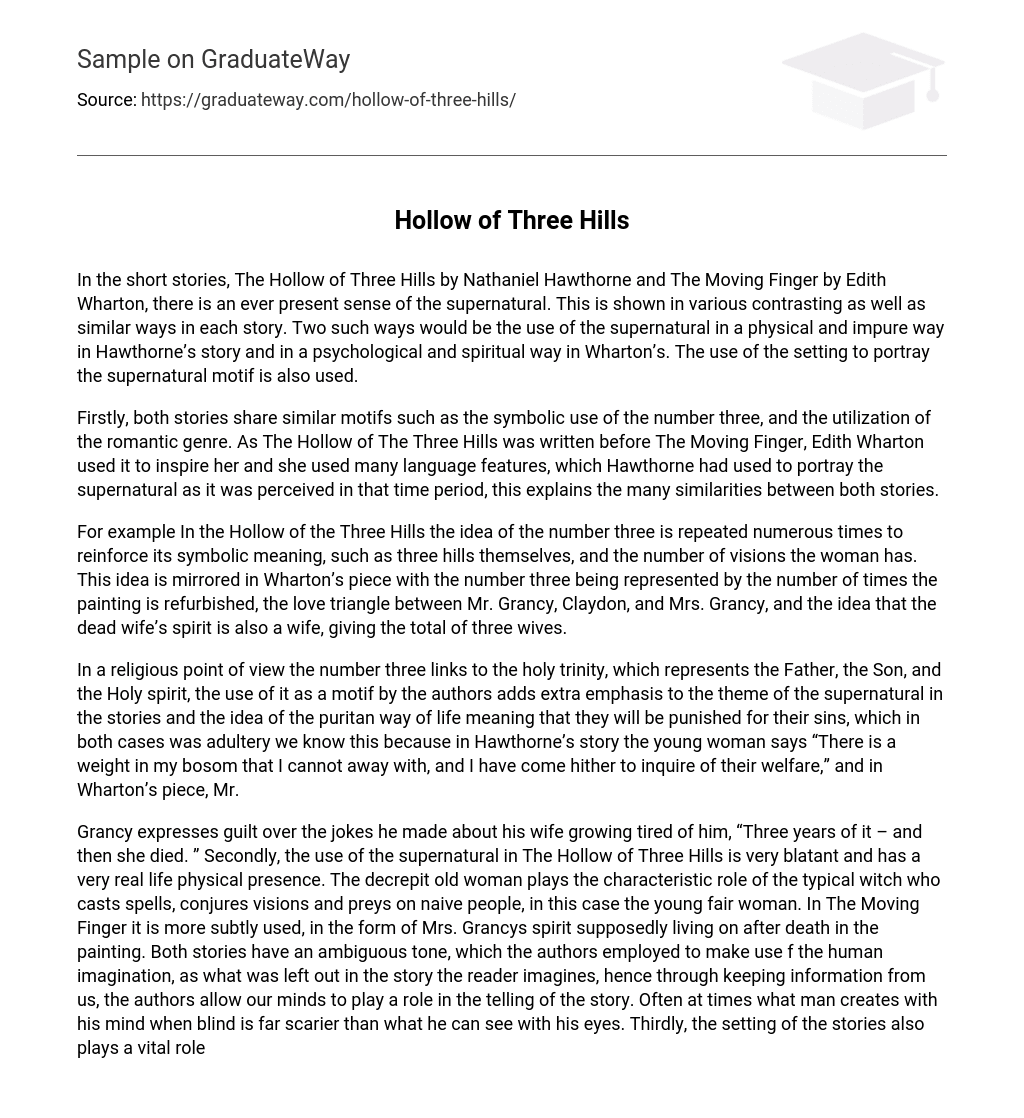Both Nathaniel Hawthorne’s “The Hollow of Three Hills” and Edith Wharton’s “The Moving Finger” possess a constant presence of the supernatural. Despite their differences, both stories employ the supernatural in distinct ways. Hawthorne relies on physical and impure manifestations, while Wharton explores the psychological and spiritual aspects. Additionally, both authors use the setting to convey this motif.
The Hollow of The Three Hills and The Moving Finger both include similar motifs like the symbolic use of the number three and the utilization of the romantic genre. Edith Wharton took inspiration from Hawthorne’s story, using the language features he employed to portray the supernatural as it was perceived during that time period. This accounts for the numerous similarities between the two stories.
In Wharton’s work titled “The Hollow of the Three Hills,” the significance of the number three as a symbol is highlighted through multiple references, including the presence of three hills and the woman experiencing three visions. Likewise, this idea is reflected in the narrative through the depiction of three wives: the painting being restored thrice, a love triangle involving Mr. Grancy, Claydon, and Mrs. Grancy, and the belief that the spirit of the deceased wife assumes a wife-like role, thus totaling to three wives.
The authors incorporate the number three as a motif in their stories, enhancing the supernatural theme and the notion of punishment for sins, particularly adultery. This religious symbol connects to the holy trinity, representing the Father, Son, and Holy Spirit. In Hawthorne’s story, the young woman shares her burdened heart and seeks to inquire about well-being. Similarly, in Wharton’s piece, Mr. Grancy feels guilty about jokingly suggesting his wife would grow tired of him, stating “Three years of it – and then she died.”
In The Hollow of Three Hills, the supernatural is prominently featured and manifested in a tangible physical form. The elderly woman, appearing frail and worn-out, assumes the traditional persona of a witch. She employs spells, evokes visions, and preys upon unsuspecting individuals, particularly targeting the young and innocent woman.
Both The Moving Finger and the aforementioned story employ subtle ambiguity. In The Moving Finger, this is exemplified by Mrs. Grancy’s spirit supposedly persisting in the painting even after death. Both authors skillfully utilize this ambiguous tone to captivate the reader’s imagination. By intentionally excluding specific details from the narrative, they encourage our minds to actively participate in constructing the story.
Often, the things that a person envisions in their mind when they are unable to see can be far more frightening than what is actually visible. Moreover, the location where these stories occur plays a vital role in depicting the supernatural aspects. In “The Hollow of Three Hills,” Hawthorne establishes a setting that resembles a horror or supernatural narrative. The inclusion of the ‘witching hour’ further enhances the existence of enigmatic and unsettling paranormal forces.
The descriptive language employed creates the impression of an isolated and gloomy swamp. The atmosphere is further enhanced by the gray and lifeless tone of the surroundings, with a stagnant pool of green water and decaying vegetation. Additionally, the use of the setting allows for the presence of supernatural elements in the story, as the hollow basin is described as having an almost perfectly circular shape. Hawthorne utilizes this detail because during that era, any naturally occurring object with such a flawless shape was perceived as inherently sinister, due to its improbability of attaining such perfection.
The setting in the Moving Finger is not as significant. Instead, the focus is on the painting’s grandeur and mysterious qualities that deeply captivate Mr. Grancy and Claydon, driving them to madness. Ultimately, the story highlights the fundamental role of the supernatural, which is consistently portrayed throughout.





